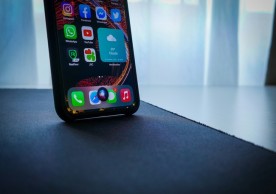Snapdragon 8 Gen 4 and A18: Benchmark Scores Suggest iPhone Dominance Might Be Waning
Snapdragon 8 Gen 4 and A18: Benchmark Scores Suggest iPhone Dominance Might Be Waning
Austin JayQualcomm's Snapdragon 8 Gen 4 is preparing to take on Apple's A18 in a technological confrontation, and benchmark results may indicate a change in the power dynamics of smartphone processors. As the rivalry intensifies, the Qualcomm CPU is anticipated to outperform the A18, potentially reversing the long-running dispute between Android and Apple smartphones.
Qualcomm's Snapdragon 8 Gen 4 Takes Center Stage
The Snapdragon 8 Gen 4, expected to debut in October, promises to outperform its predecessor and even the mighty A18 that will drive the iPhone 16. Benchmarks leaked from South Korea suggest that the Snapdragon 8 Gen 4 could achieve a single-core score 3,500, surpassing the expected 3,300 score of the A18.
Fueling this potential triumph is the introduction of Oryon cores, a custom design by Qualcomm, marking a departure from the previously licensed Arm cores. Qualcomm's acquisition of Nuvia in 2021 set the stage for this transformation, aligning the company to better compete with Apple. The move to a 3nm chip architecture and the exclusive use of Phoenix performance cores also contribute to the Snapdragon 8 Gen 4's anticipated speed boost.
However, caution is advised as leaked specifications, including a prime core clocked at 4.3 GHz and potential power consumption of 1.3V, raise concerns about overheating.
Qualcomm might be testing various versions of the chip, and if the leak proves accurate, the A18 might maintain its lead.
A18 Pro: Apple's Countermove
While the obvious A18 is predicted to come next year with the release of the iPhone 16 series, the A18 Pro is also rumored to be processed for the iPhone 16 Pro and iPhone 16 Pro Max. The initial Geekbench 6 scores showed a single-core performance of 3500, yielding a 14% speed increase concerning the M3 family by Apple and a 23% increase in the allegedterms Snapdragon 8 Gen 4 scores.
Nevertheless, Gigabyte 8 Gen 4's heterogeneous script portrays a different picture, with it leading the race Geekbench 6 by 29% in the multi-core test. Apple's '2 + 6' CPU cluster, involving the use of two chips and six cores, faces Qualcomm's optimized version of a single chip with eight cores, which demonstrates that the struggle is not that simple.
Also Read: IPhone 16 Unveils Revolutionary Capture Button, Dominating USB-C Upgrade And Action Feature
A Shifting Landscape: Implications for Consumers
As these leaked news and rumors started to spread, the consequences for consumers had to be understood. The Snapdragon 8 Gen 4 could be the new smartphone king, ruling over the A18, which might instead be the queen of the new smartphone hub. While the competition in performance among Android devices could be hard to beat for the popularity of iPhones, the entry of more players is definitely going to alter the smartphone market's dealings.
This marks a new time for the users, as the new generation of Android mobile devices will be armed with potent and high-performance features that can even leave the iPhone flagships behind or at least be on par.
The competition between Qualcomm and Apple that manifested in advanced smartphones propelled both companies to innovative devices loaded with faster, more efficient, and technologically advanced smartphones.
The Snapdragon 8 Gen 4 vs. A18 saga is unfolding, and the stakes are high. Whether Qualcomm can deliver on its promises or Apple will continue to hold its ground remains to be seen. Smartphone enthusiasts await the official releases and real-world performance tests to determine the true winner in this battle of processing power. The days of iPhone dominance are facing a formidable challenge, ushering in a new chapter in the ever-evolving world of mobile technology.
Related Article: IPhone 16 Pro's Entire Design Possibly Leaked In New Report
most read
related stories
more stories from News
-
Walmart CEO Ephasizes Walmart App Usage in Stores Amidst Reevaluation of Self-Checkout Systems
Walmart CEO emphasizes Walmart app usage in stores amidst a reevaluation of self-checkout systems. Learn more by reading the article!
ernest hamilton -
One UI 6.1.1 Reportedly Introducing Video AI Features to Samsung Devices
One UI 6.1.1 reportedly introduces exciting video AI features to Samsung devices. Explore the latest enhancements!
ernest hamilton -
Tencent Set to Launch 'Dungeon and Fighter' Mobile Game in May
Tencent is gearing up to launch the 'Dungeon and Fighter' mobile game in May, promising an exciting new gaming experience for fans of the franchise.
ernest hamilton -
Apple Confirms iPhone AI Plans with New Software Release, Unveils Eight Small AI Language Models for On-Device Use
Apple's latest software release confirms iPhone AI plans, unveiling eight small AI language models for on-device use, promising enhanced performance and privacy.
ernest hamilton -
HMD's Debut Self-Branded Phones: All Under $200
HMD introduces budget-friendly phones, all under $200, promising affordability without compromise.
ernest hamilton -
Google Rolls Out Android 15 Beta 1.2, Offering Pixel Devices Additional Bug Fixes
Experience the latest Android 15 Beta 1.2! Pixel users, unlock additional bug fixes and enhancements now!
ernest hamilton -
Google-Backed Glance Launches Pilot of Android Lockscreen Platform in US
Check out the latest from Glance! They're piloting their Android Lockscreen Platform in the US. Don't miss it!
ernest hamilton -
X Plans Smart TV App, Promising Immersive Entertainment Experience
Exciting news! X plans to launch a Smart TV app for an immersive entertainment experience. Stay tuned!
ernest hamilton















